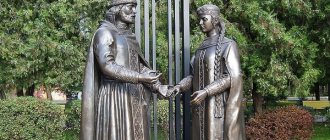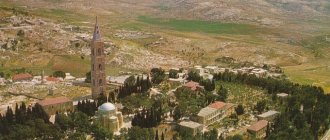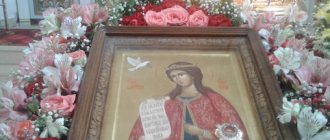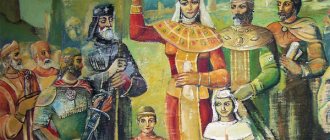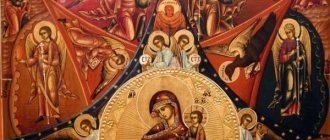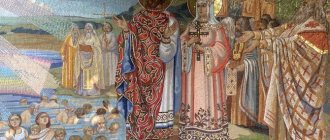Confessor Tamar (Marjanova), abbess
Brief life of the Venerable Confessor Tamar (Marjanova)
Schema-Abbesses Tamar, in the world Princess Tamara Alexandrovna Mardzhanishvili (Mardzhanova), was born on April 1, 1868 in Georgia.
After the death of her parents, she took monastic vows at the monastery of St. Nina Equal to the Apostles in Bodby with the name Juvenalia. In 1905, by decree of the Holy Synod, she was appointed abbess of the Intercession Convent in Moscow. In 1910, through her efforts, the construction of the Seraphim-Znamensky monastery near Moscow began, where in 1915 she was tonsured into the great schema with the name Tamar. In 1924 the monastery was closed. In 1931, schema-abbess Tamar and two sisters of her monastery were arrested and sentenced to exile to the Irkutsk region. After the end of her exile, she, already seriously ill with tuberculosis, returned to Moscow and on June 23, 1936, went to the Lord.
On December 22, 2021, the Holy Synod of the Georgian Patriarchate decided to canonize Reverend Confessor Tamar (Marjanova).
On December 28, 2021, the Holy Synod of the Russian Orthodox Church decided to include the name of the saint in the calendar, defining the celebration of her memory on June 10/23, as established in the Georgian Church.
The complete life of the Venerable Confessor Tamar (Marjanova)
Schema-Abbesses Tamar, in the world Princess Tamara Alexandrovna Mardzhanova, was born in the late sixties of the last century. She came from a wealthy Georgian family and received a very good upbringing and education.
In the family of princes Marjanov, the atmosphere was more secular than churchly: piety was obviously of a traditional nature, as in many secular families of that time. Tamara Alexandrovna's father died when she was still very young, her mother died when she was twenty years old.
Tamara Alexandrovna had great musical abilities and a good voice; she was preparing to enter the St. Petersburg Conservatory, when her fate changed and took a completely different turn. After the death of her mother, in the summer, she, her sister and two younger brothers stayed with her aunt, her mother’s sister, in the city of Signi, not far from the recently founded convent in the name of St. Nina in Bodbe.
Once a group of young people went to see this new Bodbe monastery. We went into church: a weekday service was going on; On the choir, Abbess Yuvenalia herself read the canon, several sisters sang and served. The youth stood for a while and left the church, Princess Tamara remained alone until the end of the service. She was suddenly so amazed by this service, by this spiritual atmosphere that enveloped her, that in her soul she immediately and firmly decided to give her life to God, to become a nun. Having waited until the end of the service, she approached Mother Abbess, spoke to her, told her about her desire and asked to be accepted into the monastery.
At this time, Tamara's cousin, a fourteen-year-old boy, returned to the church looking for Tamara. He overheard a conversation between his cousin and the abbess, told others, and Tamara was laughed at: “Tamara wants to be a nun!” At home I told all my relatives, but neither ridicule, nor persuasion, nor serious arguments could change Tamara Alexandrovna’s decision. Then her family decided to entertain her in every possible way in order to distract her from the thought of the monastery. She was taken to Tiflis, taken to concerts and theaters.
“I remember,” my mother said, “that I was sitting in the theater, and my hands were fingering my rosary in my pocket.”
In the end, seeing that her relatives did not want to let her go, Princess Tamara quietly left home and went to the monastery. Her relatives found her, but Abbess Yuvenalia managed to persuade them, and they finally allowed Tamara Alexandrovna to follow the path that she had chosen.
Mother lived under the direct supervision of Abbess Juvenalia, to whom she became very attached. After some time, she was tonsured into a ryassophore, and then into a mantle with the name also Juvenalia. (Vladyka Arseny said that some people who were in the church during the tonsure saw a white dove hovering over their mother’s head.)
In 1902, Abbess Juvenalia the Elder was transferred to Moscow and appointed abbess of the Nativity Monastery, and Juvenalia the Younger was appointed Abbess of the Bodbe Monastery by the Exarch of Georgia. Thus, while still very young, mother became the abbess of the monastery of St. Nina, Equal to the Apostles, the enlightener of Georgia, a monastery in which by that time there were about three hundred sisters. At first, Mother was very sad in separation from the elder abbess Juvenalia, who became her spiritual mother and replaced her natural mother. Father John of Kronstadt provided her with great help and support at that time.
Mother loved her Bodbe Monastery very much and loved to remember it. But she herself did not have to remain abbess there for long.
In 1905, revolutionary mountaineers often attacked peaceful Georgian peasants and oppressed them in every possible way. The peasants turned to the Bodbe monastery for help, and the mother took all those offended under her protection, helped them, and sometimes provided shelter within the walls of the monastery. The revolutionaries were very irritated with the young abbess Juvenalia and sent anonymous letters threatening her. In St. Petersburg, at the Synod, they were worried about the fate of mother, who was clearly in danger, since the revolutionaries personally hated her and made attempts on her life. By decree of the Holy Synod - without the desire and even, one might say, against the wishes of the mother - she was transferred from her beloved Bodbe monastery to Moscow and appointed abbess of the Intercession community. Mother did not like to remember this period of her life.
The nuns of the Pokrovskaya community worked as sisters of mercy, just like the sisters of the Martha and Mary community, who were not nuns. Being the abbess of the Intercession community, mother became very close to Grand Duchess Elizaveta Feodorovna, who created the Martha and Mary community, always remembered her and spoke about her with special feeling.
This is how she was born and increasingly inflamed by the desire to retire, to settle alone near the Sarov Monastery, as if under the protection of St. Seraphim, who was especially close to her, and there she ended her life in a feat of prayer. But there, in Zharov, more precisely in the Seraphim-Ponetaevsky Monastery, where mother went in June 1908 and from where she went to Sarov, mother received a kind of command from the Mother of God when she prayed before Her Icon of the Sign. This wonderful suggestion was repeated several times, and mother realized that the Mother of God did not want her to end her life in solitude, but was instructing her to create a new monastery not only for herself, but also for others. Still, it was difficult for mother to give up her ardent desire for solitude, and she was afraid that the command of the Mother of God might not be a temptation. She decided to consult with an experienced confessor and in October she went to Zosimova Monastery to visit the recluse Fr. Alexy, who, after listening to mother, decisively told her that she should not retire for solitary prayer, but should and even was obliged to build a new monastery, that the Mother of God Herself was calling her to this.
Wanting to test herself again and again before starting such a serious and great undertaking, mother came to Optina Pustyn to consult with the Monk Anatoly, who also persistently convinced her to fulfill the assignment given to her by the Mother of God Herself. Several more times mother went for advice to Fr. Alexy Zosimovsky, who joyfully supported her in creating a new monastery. Returning from her last trip to Father Alexy, Mother stopped at the Trinity-Sergius Lavra to consult with the Lavra’s governor, Fr. Tobiah. In the depths of her soul, mother still hoped that Fr. Tobiah, as an experienced and businesslike person, will advise her not to take on such a difficult task. But the governor of the Lavra, having listened carefully and lovingly to mother, decisively and authoritatively blessed her to create a new monastery.
Thus, with the advice and blessing of the elders - Fr. Alexy Zosimovsky, Fr. Anatoly Optinsky and Fr. Tobias, the governor of the Trinity-Sergius Lavra, it was finally decided to create a new Seraphim-Znamensky monastery. With God's clear help, the means for this great undertaking also appeared.
On July 27, 1910, the foundation of the monastery took place on an already measured and planned site. The monastery was built from July 1910 to September 1912. In all plans for the internal and external structure of the skete, mother consulted with Bishop Arseny (Zhadanovsky), who became the confessor of mother and all the sisters of the skete in 1916 (he remained so until his death in 1937).
The consecration of the monastery took place on September 29, 1912. The skete was consecrated by Metropolitan Vladimir of Moscow, who treated mother and her new skete with great and ardent feeling.
The Seraphim-Znamensky skete lasted only twelve years. It was closed and destroyed by the Bolsheviks in 1924. The sisters went in different directions. Mother managed to find a small house in the village of Perkhushkovo, and she settled in it with ten sisters. A priest (hieromonk Filaret [Postnikov]) lived in a separate house. Mother, ten sisters and father - twelve people, “according to the number of the apostles of Christ,” said mother.
Life in Perkhushkovo improved approximately the same as in the monastery. Many came to mother for advice and guidance.
In 1931, mother was arrested along with several sisters and priest. In prison with her was her faithful novice. In the cell where mother was, there were a variety of prisoners - both political and criminal. Somehow we managed to separate a corner for mother in the common cell with something like a curtain. The criminal women often made noise and began to sing obscene songs, but when mother asked them to stop, they fell silent - everyone respected her. When mother received the parcels, she gave it to everyone who was in the cell, and everyone accepted it from her as if it were a blessing.
After the verdict, mother was exiled to Siberia, two hundred miles from Irkutsk. Needless to say, what a difficult and tiring journey it was. At the end of the path, mother had to walk. Her novice Nyusha, a simple girl, loving and selfless, went into exile with her. It is known that mother lived in a simple peasant hut, where she was given a corner behind the stove. The owner of this hut and his son Vanyusha fell in love with his mother very much. Having already returned from exile, mother corresponded with them and sent Vanyusha a cut for a shirt as a gift. And he wrote to her: “It’s a pity that you left us. Now I have a button accordion, I play all day, you should listen.” Reading this letter, mother said with a smile: “Behold, the Lord took pity on me!”
How did she endure prison and three years of exile with her sore legs and already diagnosed tuberculosis?! She was helped by her faith, willpower and enormous endurance.
In exile, my mother, like all administrative deportees, had to appear at the local commissariat two or three times a month to sign. At first the Commissioner received her very sternly, if not hostilely. But mother’s whole appearance, some kind of spiritual power shining in her eyes, gradually influenced this man; His stern tone changed, he began to sometimes talk to his mother. And when the term of exile ended, and mother came to the commissariat for the last time to sign, the commissar warmly said goodbye to her and said that he regretted that he would not see her again. Mother left, but, having walked a little along the road, she looked back and saw that the commissar had gone out onto the porch and was following her with his eyes.
My mother had been ill with her lungs for a long time. In exile, her illness worsened; it was very difficult and bad for her. In letters to her loved ones, she kept repeating that she would like to “return to her shores.” And the Lord fulfilled her wish; she miraculously remained alive and “returned to her shores.”
Mother's exile ended in 1934, in the spring. She returned and settled in a small house in a holiday village near the Pionerskaya station of the Belarusian Railway. She was already very sick. While in exile, she developed signs of throat tuberculosis; the illness gradually took away her strength.
Mother died on June 10/23, 1936. Vladyka Arseny performed her funeral service at home. She was buried in Moscow, on the Vvedensky Mountains, not far from the grave of Fr. Alexey Mechev.
Mother’s grave is still intact and in perfect order. On the grave there is a white wooden cross, in which two icons are embedded - the Sign of the Mother of God, etc. Seraphim. On the lower crossbar, with the blessing of Vladyka Arseny, the inscription was made: “Believe in Me to have an eternal life.”
Is it possible to live in the past if God gives something new?
Princess Tamara (Reverend Confessor Tamar) was born in Georgia, into a princely family, in 1868.
She grew up in love, luxury and abundance. Her father, Prince Alexander, died when Tamara was a child. Numerous relatives helped Tamara’s mother, who became the most dear person to the princess, in everything.
In her youth, Princess Tamara became seriously interested in music and was preparing to enter the St. Petersburg Conservatory, in which her mother warmly supported her. The girl decided to leave marriage for later, despite the many fans attracted by her bright beauty.
The unexpected death of her beloved mother, when the princess was barely twenty, completely changes the girl’s carefree state of mind.
Sleepless nights in tears, prayers for the repose of my mother’s soul brought questions - why did my mother leave? What is a person? Why does he live, why does he die?
Aunties, uncles, brothers and sisters tried to console Tamara and entertain her. In the summer, Tamara and her young relatives went to visit her aunt, who lived near the monastery in the city of Bodbe. The young people wanted to see the newly founded monastery. We arrived on a weekday and went into the temple. There was an evening service. The abbess of the monastery read the canon, the sisters sang. Everyone, except Tamara, stood for a couple of minutes and left.
Tamara, as she would later tell, felt something very close to her spirit here, something that she had been looking for for a long time, but could not clearly explain. When the service ended, the young princess approached the abbess and said that she felt a calling to stay in this monastery. The abbess replied that this is a very good desire, but also a great responsibility.
Tamara’s cousin heard the conversation and told her family that her sister was going to a monastery. And then the textbook began: the youth teased (gently) “nun”, uncles and aunts asked to come to their senses, “not to ruin your youth” and offered many entertainments, especially musical ones, knowing how deeply Tamara loved music.
The princess saw the sincere care of her relatives and was grateful to them, but, going to concerts and guests, she was only convinced that no, this was already the past, and it gave no more than life.
And in the monastery she felt that life could continue, but in a different way. It was very difficult to convey in words, to convey to the secular people who were her relatives. They asked - Tamara answered - they did not understand.
And in the person of the abbess, Tamara saw “a continuation of her mother,” the one with whom she could openly share everything that was in her soul, the one who did not need to “explain” what was happening to her. And, when Princess Tamara was invited to a concert or to the theater, her hands slowly fingered her rosary.
Finally - again textbook and completely truthful - after many useless persuasions to let her go to the monastery, Tamara decided to run away from home.
The abbess accepted Tamara as her own daughter, and now the girl’s happiness was darkened only by the anticipation of the anger of her relatives. Soon the aunts came to pick up their niece. They asked the abbess to convince the girl to return home, but the opposite happened: the abbess convinced the aunts to leave Tamara alone.
Soon Tamara took monastic vows with the name Juvenalia, like the abbess. During the tonsure, a white dove circled over Tamara’s head.
